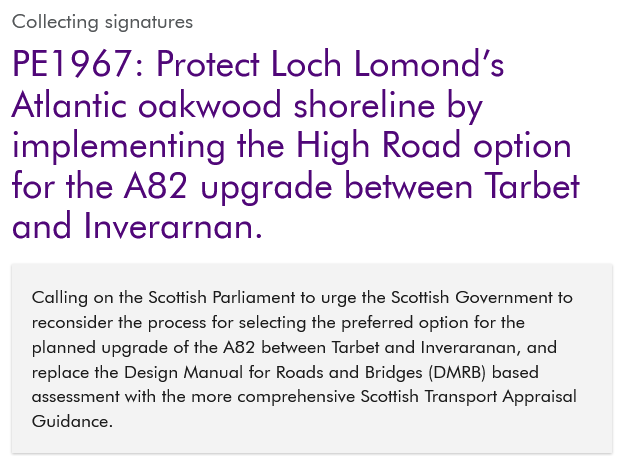
https://petitions.parliament.scot/petitions/PE1967
In February (see here) I looked at decision making by Transport Scotland on the A82 Tarbet to Inverarnan and the inaction of the National Park Authority. Their view has been that Transport Scotland is the statutory lead for major road development and that as a statutory consultee their main role is to comment once the final plans are produced when they can object if they are unhappy with the result. As my post tried to make clear this is simply not true; the proposal should have been examined using the STAG (Cost Benefit) framework with the implications for the National Park central to the analysis and the National Park Authority should have been saying this loud and clear.
The decision to spend £9.1m on the viaduct around Pulpit Rock illustrates how Transport Scotland (TS) made a decision that wasted a huge amount of public money. TS and the public recognised the need for improvement of the A82 Glasgow to Fort William. Such a huge project was inevitably broken down into a series of achievable projects such as the Crianlarich by-pass. In most cases the implications for the public, both local and national, apart from improving the journey (making it quicker and safer) were relatively small and the absence of a properly constituted STAG appraisal was unimportant.
When the section between Inverarnan and Tarbet was considered, a project to remove the single tracking at Pulpit Rock was proposed. When Argyll and Bute Council and the National Park were consulted both responded that there was a need for consideration of the whole route. This was ignored by TS who pressed ahead with the Pulpit Rock scheme. Interestingly Argyll and Bute’s response also included a request for consideration of Active Travel, a cycle path. TS replied that this would be in the design but subsequently ignored it. The National Park Authority conceded that the small negative environmental impact gave them limited grounds for objecting to the scheme, although it would clearly be a waste of over £9m if the shore route was not chosen at a later date. Officials in the two authorities recognised that potentially a massive mistake was in the making but could do nothing about it.
If each viaduct/bend straightening had been submitted as individual applications, it is doubtful that our planning system could have prevented any single project. However, as soon as the whole route came to be considered, an “appraisal” of alternative routes was required. Such an appraisal required route costings and consideration of the wider costs and benefits. If Pulpit Rock was not to be seen as a massive waste of money it was essential that the appraisal suggested that the High Route was clearly too expensive and potentially worse for the environment.
The only plan that is publicly available showed no tunnels. However the costing spreadsheet included three. The cost for each tunnel was then set at three times the norm; equivalent to the cost of the most expensive rail tunnel under London. At its most generous it might just be possible to suggest a simple mistake, were it not for an added cycle route that under no circumstances would be needed. On the other hand the numerous road closures for the shore side route, an estimated 300, were ignored in the analysis.
It was difficult not to get angry at the dishonesty of the costing but this was small compared to the dishonesty of a “Value for Money” seminar that was meant to consider the wider picture. This consisted of only TS officials and consultants and found, apparently, a village environment is more advantageous to the handicapped and disadvantaged if a busy trunk road cuts it in two. Similarly the destruction of the ancient oak woodland and construction of huge concrete viaducts over the loch were determined as less destructive to the environment than a new road high up on the hillside. Noise impacts, we are informed, would be equal despite the known effect of noise carrying over water. The high route, despite lacking sharp blind bends, would be more dangerous because there might be a greater chance of snow and ice. Public acceptability was equal because a stakeholder meeting had heard only limited objections to the only proposal submitted, the shoreside route. And so on. The conclusion was that the shoreside route offered double the value for money.
It is clear that this disgraceful, bogus “appraisal” has to be redone in the manner legally required and, to that end, the Helensburgh and District Access Trust (HADAT) and the Friends of Loch Lomond and Trossachs have launched a petition asking the Scottish Parliament to ensure this has been done before any further finance is allocated. If you are as worried about the integrity of the transport planning system or are simply worried about the destruction of the environment please could you sign the petition found at https://petitions.parliament.scot/petitions/PE1967 and make sure your family and friends know about it.